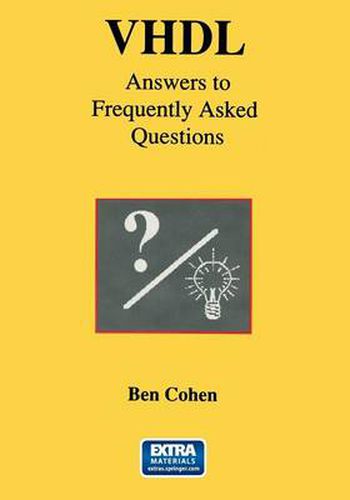Readings Newsletter
Become a Readings Member to make your shopping experience even easier.
Sign in or sign up for free!
You’re not far away from qualifying for FREE standard shipping within Australia
You’ve qualified for FREE standard shipping within Australia
The cart is loading…






This title is printed to order. This book may have been self-published. If so, we cannot guarantee the quality of the content. In the main most books will have gone through the editing process however some may not. We therefore suggest that you be aware of this before ordering this book. If in doubt check either the author or publisher’s details as we are unable to accept any returns unless they are faulty. Please contact us if you have any questions.
VHDL Answers to Frequently asked Questions is a follow-up to the author’s book VHDL Coding Styles and Methodologies (ISBN 0-7923-9598-0). On completion of his first book, the author continued teaching VHDL and actively participated in the comp. lang. vhdl newsgroup. During his experiences, he was enlightened by the many interesting issues and questions relating to VHDL and synthesis. These pertained to: misinterpretations in the use of the language; methods for writing error free, and simulation efficient, code for testbench designs and for synthesis; and general principles and guidelines for design verification. As a result of this wealth of public knowledge contributed by a large VHDL community, the author decided to act as a facilitator of this information by collecting different classes of VHDL issues, and by elaborating on these topics through complete simulatable examples. This book is intended for those who are seeking an enhanced proficiency in VHDL. Its target audience includes: 1. Engineers. The book addresses a set of problems commonly experienced by real users of VHDL. It provides practical explanations to the questions, and suggests practical solutions to the raised issues. It also includes packages to achieve common utilities, useful in the generation of debug code aDd testbench designs. These packages include conversions to strings (the IMAGE package), generation of Linear Feedback Shift Registers (LFSR), Multiple Input Shift Register (MISR), and random number generators.
$9.00 standard shipping within Australia
FREE standard shipping within Australia for orders over $100.00
Express & International shipping calculated at checkout
This title is printed to order. This book may have been self-published. If so, we cannot guarantee the quality of the content. In the main most books will have gone through the editing process however some may not. We therefore suggest that you be aware of this before ordering this book. If in doubt check either the author or publisher’s details as we are unable to accept any returns unless they are faulty. Please contact us if you have any questions.
VHDL Answers to Frequently asked Questions is a follow-up to the author’s book VHDL Coding Styles and Methodologies (ISBN 0-7923-9598-0). On completion of his first book, the author continued teaching VHDL and actively participated in the comp. lang. vhdl newsgroup. During his experiences, he was enlightened by the many interesting issues and questions relating to VHDL and synthesis. These pertained to: misinterpretations in the use of the language; methods for writing error free, and simulation efficient, code for testbench designs and for synthesis; and general principles and guidelines for design verification. As a result of this wealth of public knowledge contributed by a large VHDL community, the author decided to act as a facilitator of this information by collecting different classes of VHDL issues, and by elaborating on these topics through complete simulatable examples. This book is intended for those who are seeking an enhanced proficiency in VHDL. Its target audience includes: 1. Engineers. The book addresses a set of problems commonly experienced by real users of VHDL. It provides practical explanations to the questions, and suggests practical solutions to the raised issues. It also includes packages to achieve common utilities, useful in the generation of debug code aDd testbench designs. These packages include conversions to strings (the IMAGE package), generation of Linear Feedback Shift Registers (LFSR), Multiple Input Shift Register (MISR), and random number generators.